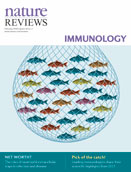|
Advertisement | ||||||||||||||||||||||||||||||||||||||||
| ||||||||||||||||||||||||||||||||||||||||
| TABLE OF CONTENTS | ||||||||||||||||||||||||||||||||||||||||
| February 2018 Volume 18 Number 2 | Advertisement | |||||||||||||||||||||||||||||||||||||||
| In this issue
|
| ||||||||||||||||||||||||||||||||||||||
| ||||||||||||||||||||||||||||||||||||||||
 | ||||||||||||||||||||||||||||||||||||||||
| Advertisement | ||||||||||||||||||||||||||||||||||||||||
| ||||||||||||||||||||||||||||||||||||||||
| Advertisement | ||||||||||||||||||||||||||||||||||||||||
| ||||||||||||||||||||||||||||||||||||||||
| Advertisement | ||||||||||||||||||||||||||||||||||||||||
| ||||||||||||||||||||||||||||||||||||||||
| ||||||||||||||||||||||||||||||||||||||||
| YEAR IN REVIEW | Top | |||||||||||||||||||||||||||||||||||||||
| Immunometabolism in 2017: Driving immunity: all roads lead to metabolism Edward J. Pearce & Erika L. Pearce p81 | doi:10.1038/nri.2017.139 In 2017, studies of cellular metabolism broadly permeated immunological research. Accumulating data support the view that understanding how metabolism regulates immune cell function could provide new therapeutic opportunities for the many diseases associated with immune system dysregulation. Full Text | PDF | ||||||||||||||||||||||||||||||||||||||||
| Neuroimmunology in 2017: The central nervous system: privileged by immune connections Jonathan Kipnis & Anthony J. Filiano p83 | doi:10.1038/nri.2017.152 Over the past few years, interest in the field of neuroimmunology has expanded dramatically, thanks largely to new technologies that have advanced our understanding of the intimate connections between the nervous and immune systems. Here, we highlight key advances in 2017 that have defined new roles for microglia in brain maintenance, for cytokines as neuromodulators and for the immune system in peripheral nerve activity. Full Text | PDF | ||||||||||||||||||||||||||||||||||||||||
| Macrophages and monocytes in 2017: Macrophages and monocytes: of tortoises and hares Steffen Jung p85 | doi:10.1038/nri.2017.158 Monocytes and tissue macrophages represent two main branches of the mononuclear phagocyte system, and they have complementary roles during immunological challenges. Several studies published in 2017 highlighted the distinct properties of these two cell types and furthered our understanding of their development and cellular functions. Full Text | PDF | ||||||||||||||||||||||||||||||||||||||||
| Cancer immunotherapy in 2017: The breakthrough of the microbiota Guido Kroemer & Laurence Zitvogel p87 | doi:10.1038/nri.2018.4 In 2017, epidemiological studies in humans and experiments in mouse models showed that the intestinal microbiota determines the effectiveness of anticancer immunotherapies. As such the microbiota offers new prognostic biomarkers and shows promise as a target for future antineoplastic treatments. Full Text | PDF | ||||||||||||||||||||||||||||||||||||||||
| Vaccines in 2017: Closing in on a Zika virus vaccine Michael S. Diamond & Carolyn B. Coyne p89 | doi:10.1038/nri.2017.132 Over the past 2 years, Zika virus (ZIKV) has emerged as a pathogen capable of causing devastating congenital malformations in the developing fetus and significant neurological disease in adults. In 2017, substantial progress has been made towards the development, immunological analysis and preclinical evaluation of vaccine platforms to prevent the pathologies associated with ZIKV infection. Full Text | PDF | ||||||||||||||||||||||||||||||||||||||||
| REVIEWS | Top | |||||||||||||||||||||||||||||||||||||||
| Immune checkpoint blockade in infectious diseases Michelle N. Wykes & Sharon R. Lewin p91 | doi:10.1038/nri.2017.112 Recent clinical trials have shown that blocking immune checkpoint molecules can boost antitumour immune responses. In this Review, the authors consider whether targeting these pathways could also be used to combat a range of infectious diseases, such as malaria, tuberculosis and chronic viral infections. Abstract | Full Text | PDF | ||||||||||||||||||||||||||||||||||||||||
| The hygiene hypothesis in autoimmunity: the role of pathogens and commensals Jean-Francois Bach p105 | doi:10.1038/nri.2017.111 The hygiene hypothesis postulates that an increased frequency of infections contributes to a decrease in autoimmune and allergic diseases. Here, Bach summarizes the epidemiological and experimental evidence supporting this hypothesis and discusses the importance of innate immune receptors in mediating the protective effect of pathogens and commensals on autoimmunity. Abstract | Full Text | PDF | ||||||||||||||||||||||||||||||||||||||||
| TH2 cell development and function Jennifer A. Walker & Andrew N. J. McKenzie p121 | doi:10.1038/nri.2017.118 This Review describes our current understanding of the mechanisms regulating T helper 2 (TH2) cell development and function. The authors discuss how our increasing comprehension of these pathways is leading to the development of novel therapies for TH2 cell-mediated diseases, such as asthma and allergy. Abstract | Full Text | PDF | ||||||||||||||||||||||||||||||||||||||||
| Neutrophil extracellular traps in immunity and disease Venizelos Papayannopoulos p134 | doi:10.1038/nri.2017.105 Neutrophil extracellular traps (NETs) protect against infection, but they are also implicated in the pathology associated with various immune-mediated conditions. This Review describes when and how they are formed, how they function and how they are regulated. Abstract | Full Text | PDF | ||||||||||||||||||||||||||||||||||||||||
| CORRESPONDENCE | Top | |||||||||||||||||||||||||||||||||||||||
| Are histones real pathogenic agents in sepsis? Isaac Ginsburg & Erez Koren p148 | doi:10.1038/nri.2017.156 Full Text | PDF | ||||||||||||||||||||||||||||||||||||||||
| REPLY | Top | |||||||||||||||||||||||||||||||||||||||
| Are histones real pathogenic agents in sepsis? Tom van der Poll, Frank L. van de Veerdonk, Brendon P. Scicluna & Mihai G. Netea p148 | doi:10.1038/nri.2017.157 Full Text | PDF | ||||||||||||||||||||||||||||||||||||||||
| ||||||||||||||||||||||||||||||||||||||||
| You have been sent this Table of Contents Alert because you have opted in to receive it. You can change or discontinue your e-mail alerts at any time, by modifying your preferences on your nature.com account at: www.nature.com/myaccount For further technical assistance, please contact our registration department For print subscription enquiries, please contact our subscription department For other enquiries, please contact our feedback department Springer Nature | One New York Plaza, Suite 4500 | New York | NY 10004-1562 | USA Springer Nature's worldwide offices: Macmillan Publishers Limited is a company incorporated in England and Wales under company number 785998 and whose registered office is located at The Campus, 4 Crinan Street, London, N1 9XW. © 2018 Macmillan Publishers Limited, part of Springer Nature. All Rights Reserved. |
 |









No comments:
Post a Comment